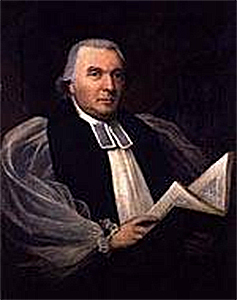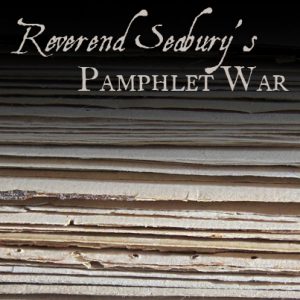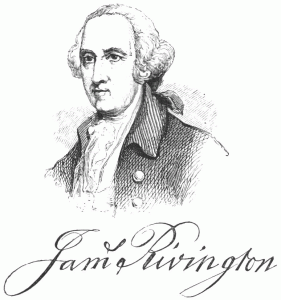
In the fall of 1774, just before adjourning, the First Continental Congress outlined the Articles of Association, an aggressive plan of economic resistance to Great Britain that included nonconsumption, nonimportation and nonexportation. These boycotts were to be enforced by local committees and supplant Colonial governments. Westchester, New York Reverend Samuel Seabury responded with a series of pamphlets that started a war of words in the state, drew unwanted attention from Patriot militia and escalated to property destruction and capture.
Rev. Samuel Seabury was the rector of St. Peter’s Church in West Chester, New York (West Chester was a village in Westchester County where Seabury lived). A very large and strong-willed man, Seabury strongly supported the Stamp Act back in 1765 and remained staunchly loyal to the Crown in each succeeding controversy. Age 45 at the time of the First Continental Congress, he was outspoken and influential on a number of issues that ranged far beyond the scope of religion. Indeed, by the time of the revolution, Seabury possessed excellent writing skills and had been published on a number of occasions.[i]
The reverend refused to stand silent in the face of this open rebellion or rule by Committee which he likened to mob and bully tactics. Seabury took to his pen and dashed off a very nice piece of protest called Free Thoughts on the Proceedings of the Continental Congress. He signed the piece “A. W. Farmer” and sent the pamphlet to New York’s loyalist printer, James Rivington, for publication in November of 1774. Seabury addressed his essay to “You the Farmers of the Province of New York” and claimed to be one himself. He argued directly and effectively against the comprehensive commercial opposition passed by the delegates. Seabury predicted economic ruin from blockading ports, and depressed flaxseed and land prices.[ii]
Within a month, Rivington’s Gazetteer proudly announced an upcoming response to Seabury’s Free Thoughts. A young student at King’s College named Alexander Hamilton submitted his well-written Full Vindication of the Measures of Congress as the promised response. Hamilton tried to dismiss Seabury but his pamphlet had little impact on the people of Westchester, who remained loyal to both church and Crown.[iii]
Rev. Seabury’s second pamphlet was already written when Hamilton’s Vindication came out. This time Seabury addressed it “To the Merchants of New York” using economic arguments that blamed New England for the trouble with England. At the end, A. W. Farmer acknowledged Hamilton’s pamphlet and challenged him to continue a debate in the press, offering to wait 10 days before publishing his next pamphlet. Baiting Hamilton further, Seabury supposed the time more than enough “for so very accomplished a writer to ridicule all the wit contained” in the letters of A. W. Farmer.[iv]
Hamilton, 18 years old at the time, declined the invitation to debate further, but did post a short public rebuttal claiming “no necessity to communicate” further since he felt the loyalists were “too much blinded to perceive the force of just argumentation.”[v]
Seabury went right for the literary jugular. His View of the Controversy Between Great-Britain and her Colonies was directed right at Hamilton and his Vindication. Still operating as A. W. Farmer, the reverend claimed the right of all Englishmen to openly enjoy his freedom of thought and expression. He “freely own[ed]” to having “published the Free Thoughts with a design to “diminish the influence” of Congress and working to prevent the Association. Seabury mocked Hamilton for having spoken of “the impotence” of his attempts to sway the people of New York by pointing out how his pamphlets “have been rapidly purchased, and eagerly read; notwithstanding the general indignation of which you speak.”[vi] A. W. Farmer pointed out that Loyalism was winning in the countryside and he sees “the influence of Congress daily diminishing.”
 Rev. Seabury and his friends rode a strong wave of support for several weeks. Printing Loyalist pamphlets at twice the rate of Whig responses, Rivington soon advertised a list of 13 related to the “present Controversy between Great-Britain and the Colonies”. His ad even included a large discount for “Purchasers by the Dozen, of the above articles, to give away.”[vii] A. W. Farmer’s message came through loud and clear: The boycotts would bring economic collapse, the Continental Congress represented mob rule and the British Army would soon appear to wipe away the rebel activists.
Rev. Seabury and his friends rode a strong wave of support for several weeks. Printing Loyalist pamphlets at twice the rate of Whig responses, Rivington soon advertised a list of 13 related to the “present Controversy between Great-Britain and the Colonies”. His ad even included a large discount for “Purchasers by the Dozen, of the above articles, to give away.”[vii] A. W. Farmer’s message came through loud and clear: The boycotts would bring economic collapse, the Continental Congress represented mob rule and the British Army would soon appear to wipe away the rebel activists.
By April 1775 Seabury and the other Loyalist leaders had organized significant opposition to sending any delegates to the Second Continental Congress. They met on April 11 in large numbers which resulted in 316 loyalists proudly signing a proclamation of loyalty and submitting it for publication in the Gazetteer. Among other things, the statement declared “our honest abhorrence of all unlawful Congresses and Committees and that we are determined, at the hazard of our lives and properties, to support the King and Constitution; and that we acknowledge no Representatives but the General Assembly, to whose wisdom and integrity we submit the guardianship of our rights, liberties, and privileges.”[viii] The names Philipse, Wilkins, Seabury, and Babcock appeared prominently at the top of the list. They claimed to represent the majority of Westchester County residents, declaring any opposing votes to be the acts of “a few individuals, unlawfully assembled.”[ix]
Whigs from New York vehemently denied the idea that Loyalists represented the majority in Westchester County. Lewis Morris tracked down all the signers of the Tory declaration and found almost half of them too young or otherwise ineligible for voting. He declared, the “truth really is that very few independent freeholders objected to the Deputies.”[x]
Seabury and the others quickly became “objects of revenge.” Intending to seize the leaders, troops from New England marched into the county getting as close as Rye, only 15 miles distant. At that point a young man arrived at Seabury’s home with warning and “that very night, they were obliged to retire for some time.”[xi] In fact, the reverend and two others hid in the cellar of the Old Wilkins Mansion on Castle Hill Neck where “Food was conveyed to them through a trap-door in the floor” that had been so carefully crafted under the chimney that a “persevering search” of the premises failed to reveal its location.[xii]
When the dust settled a few weeks later, Isaac Wilkins crossed over to Long Island and then sailed for England but Rev. Seabury elected to return home where he “continued unmolested though occasionally reviled by particular people for not paying obedience to the order of Congress enjoining fast days.”[xiii] Unfortunately for Seabury, the notoriously zealous Isaac Sears of Connecticut focused his attention on Rivington’s press and the Loyalist papers. Active with the Sons of Liberty all the way back to the Stamp Act, Sears organized a raid into New York for the joint purposes of destroying Rivington’s press and seizing the Loyalist leaders in Westchester.[xiv]

On November 23, Sears led 75 mounted men into New York where they moved directly to Rivington’s on Wall street. He “placed a guard with fixed bayonets around it, put all of his types into bags, destroyed his press and other apparatus, and then in the same order, amid the shouts of the populace, and to the tune of Yankee Doodle, left the city. They carried off the types and made bullets of them. On their way back to Connecticut they disarmed all the Tories in their route, and at West Chester seized and took with them the Reverend Samuel Seabury and two other obnoxious Tories, and carried them in triumph to New Haven.”[xv] According to Seabury himself, “an armed force of 100 horsemen came from Connecticut to his House, & not finding him at home they beat his children to oblige them to tell where their father was – which not succeeding they searched the neighborhood and took him from his school, & with much abusive language carried him in great triumph to New Haven 70 miles distant, where he was paraded through most of the streets, & their success celebrated by firing of Cannon.”[xvi]
Charged with four crimes that included, conspiring to kidnap Isaac Spears, signing the Loyalist petition in Westchester County, failing to open his church on a special day of fasting called by Congress, and for authoring the famous letters from A. W. Farmer, Rev. Seabury remained a prisoner with no visits from friends. Seabury had plenty of time to consider his appeal to the Connecticut Assembly for release from captivity. Completed just before Christmas, the document contained a very detailed and damning description of the treatment his family received at the hands of Sears and his men. He included the “pointing a bayonet at the breast” of his daughter and having his wife suffer the indignity of watching them go through his private papers. Seabury rejected any prior conspiracy against Isaac Spears and, despite being generally accepted among historians today, he denied authoring the famous pamphlets. Seabury closed his appeal with a personal observation that his family needed support and the children in West Chester needed a teacher.[xvii]
Seabury returned to his family after Christmas and things quieted for a time but, after the British abandoned Boston in April 1776, large groups of soldiers passing by “every day or two, sometimes two or three times a day” would stop by Seabury’s house “I believe only for the malicious pleasure of insulting me by reviling the king, the Parliament, Lord North, the Church, the bishops, the clergy, and the Society, and above all, that vilest of all miscreants, A. W. Farmer. One would give one hundred dollars to know who he was, that he might plunge his bayonet into his heart”[xviii]
When Howe landed at Long Island and defeated the Patriot army, Seabury’s situation in West Chester grew ever more precarious and, in September of 1776, he opted for the safety of Long Island. He remained behind British lines living off various pensions for service as chaplain for the duration of the war even being named chaplain of the King’s American Regiment. After the war Seabury elected to remain in America and help restore the Church in New York. He found plenty of friends remaining in Connecticut and petitioned Church officials in England to make him the First Bishop in the United States. “He was consecrated in old St. Andrew’s Church, Aberdeen, 14 November 1784” and became Bishop Seabury, never publicly acknowledging his authorship of the famed Letters of A. W. Farmer.[xix]
[i] Judd, Jacob, Westchester County, The Other New York, edited by Tiedemann, Joseph S., and Fingerhut, Eugene R., State University of New York Press, Albany, (2005), p. 112, See Also – Hufeland, Otto, Westchester County during the American Revolution, Westchester County Historical Society, White Plains, New York, (1926) p. 17-18 .
[ii] Seabury, Samuel, Free Thoughts on the Proceedings of the Continental Congress, November 1774, Rivington Press, New York, (1774) and reprinted by the Westchester County Historical Society as, Seabury, Samuel, Letters of a Westchester Farmer, Vance, Clarence, editor, (1930) and republished by the Da Capo Press, New York (1970) p. 44.
[iii] Hamilton, Alexander, A Full Vindication of the Measures of the Congress, from the Calumnies of their Enemies; In Answer to A Letter, Under the Signature of A. W. Farmer., reprinted in the Library of America’s, Alexander Hamilton Writings, New York (2001), p. 10.
[iv] Seabury, Samuel, The Congress Convassed: or, An Examination into the Conduct of the Delegates, at their Grand Convention, Held in Philadelphia, September 1, 1774, Rivington Press, New York (1774) and, reprinted by the Westchester Historical Society as Seabury, Samuel, Letters of a Westchester Farmer, Vance, Clarence, editor (1930), and reprinted by the Da Capo Press, New York (1970), p. 71 – 99.
[v] Hamilton, Alexander under “A Card” headline in the Rivington’s Gazetteer 22 December 1774, and reprinted in: , Seabury, Samuel, letters of a Westchester Farmer, Da Capo Press, New York (1970), p. 26-27. “A Card” is thought to be short for placard.
[vi] Seabury, Samuel, A View of the Controversy Between Great-Britain and Her Colonies, Rivington Press, New York (1775) and reprinted in Seabury, Samuel, Letters of a Westchester Farmer, Vance, Clarence, editor (1930) and reprinted by Da Capo Press, New York (1970), p. 105.
[vii] Seabury, Samuel, Letters from a Westchester Farmer, Da Capo Press, New York, (1970), p. 147 for a copy of Rivington’s advertisement.
[xi] Seabury, Samuel, Memorial Setting Forth his Services and Circumstances, 20 October 1783, reprinted in Seabury, William Jones, Memoir of Bishop Seabury, Rivington’s, London (1908), P. 136-140.
[xii] Seabury, William Jones, Memoir of Bishop Seabury, Rivington’s, London, (1908), P. 140 in footnote 5 crediting the quotes and information to Bolton’s History of the Church in West Chester County, p. 86 (1855 edition).
[xiii] Seabury, Samuel, Memorial Setting Forth his Services and Circumstances, 20 October 1783, reprinted in Seabury, William Jones, Memoir of Bishop Seabury, Rivington’s, London (1908), P. 140.
[xiv] Lossing, Benson J., The Pictorial Field-Book of the Revolution, Harper & Brothers, New York (1859) and reprinted by Charles E. Tuttle & Co., Rutland, VT, (1972).
[xvi] Seabury, Samuel, Memorial Setting Forth his Services and Circumstances, 20 October 1783, reprinted in Seabury, William Jones, Memoir of Bishop Seabury, Rivington’s, London (1908) p. 142.
[xvii] Seabury, Samuel, To the General Assembly of the Governor and Company of the Colony of Connecticut, now Sitting in New Haven, in said Colony by special Order of his Honor, the Governor, Beardsley, Eben Edwards, Life and Correspondence of the Right Reverend Samuel Seabury, D. First Bishop of Connecticut, and of the Episcopal Church in the United States of America, Houghton, Mifflin, and Company, Boston, (1881) p. 36-42.










5 Comments
The Church of England refused to consecrate Seabury as a bishop. He moved on to Scotland where three non-juror bishops (who were in the line of apostolic succession but swore no allegiance to George III) agreed to consecrate him. He returned to Connecticut as the first bishop of the (now) Episcopal Church in the United States.
This article was very helpful to read. Thank you for this information.
Thanks for the kind remark. I first ran across the Rev Seabury when reviewing the general situation in Westchester County prior to the revolution. Had a few ancestors in the area known to be Loyalists and went looking for their story. I figured Seabury as a probable influence on them.
I enjoyed the article but you only comment on about Hamilton’s first response, “A Full Vindication …” You neglect to include / comment on Hamilton’s Feb. 1775 response, “The Farmer Refuted…” Any thoughts?
A more detailed focus on the later response made the article a bit long, in the early days of the JAR we labored under a fairly strict standard on length and since the article needed to move onto the story of Samuel Seabury, the fact of Hamilton’s further involvement failed to get mention. Many apologies to any Hamilton fans but I am delighted to see the article still getting some attention, please speak further to Hamilton’s ‘The Farmer Refuted. . . . “